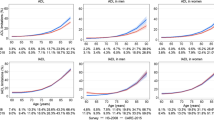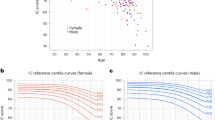Abstract
Background:
Americans are becoming obese earlier in their lives, increasing the average exposure to obesity. Nonetheless, the impact of long-term obesity on later life functioning is not well known.
Methods:
We analyzed data from 7258 adults aged 60–79 years from the US 1999–2010 National Health and Nutrition Examination Survey. Respondents were defined as limited if they reported ‘some difficulty’ ‘much difficulty’ or ‘unable to do’ any of the eight functional tasks. Respondents were defined as severely limited if they reported ‘much difficulty’ or ‘unable to do’ any task. Generalized regression models (logistic and Poisson) predicted the relative odds of any limitation, severe limitation, the total number of limitations and each individual limitation as a function of body mass index (BMI) at age 25 years and current BMI. Models were adjusted for age, sex, race/ethnicity and level of education.
Results:
Overall, being overweight or obese at age 25 years was associated with higher odds of being functionally limited, but these associations were greatly diminished or eliminated after adjustment for current BMI. For example, those obese at age 25 years had 2.38 times the odds (95% confidence interval (CI): 1.77, 3.20) of reporting any functional limitations compared with those normal weight at 25 years, but only 1.28 times the odds (95% CI: 0.93, 1.76) after adjustment for current BMI. For severe limitations, the corresponding results were 2.72 (95% CI: 2.13–3.46) and 1.32 (95% CI:1.00–1.75) before and after adjustment for current BMI. Some associations between obesity at age 25 years and individual tasks remained significant after adjustment for current BMI.
Conclusions:
We conclude that long-term overweight/obesity are significantly associated with later life functional limitations, though this is largely explained by their strong association with higher levels of later-life BMI. Prevention of additional weight gain for those who are overweight or obese early in life could help mitigate their risk of future loss of functioning.
This is a preview of subscription content, access via your institution
Access options
Subscribe to this journal
Receive 12 print issues and online access
$259.00 per year
only $21.58 per issue
Buy this article
- Purchase on Springer Link
- Instant access to full article PDF
Prices may be subject to local taxes which are calculated during checkout


Similar content being viewed by others
References
Reither EN, Hauser RM, Yang Y . Do birth cohorts matter? Age-period-cohort analyses of the obesity epidemic in the United States. Soc Sci Med 2009; 69: 1439–1448.
Flegal KM, Carroll MD, Kit BK, Ogden CL . Prevalence of obesity and trends in the distribution of body mass index among us adults, 1999-2010. JAMA 2012; 307: 491–497.
Beswick AD, Rees K, Dieppe P, Ayis S, Gooberman-Hill R, Horwood J et al. Complex interventions to improve physical function and maintain independent living in elderly people: a systematic review and meta-analysis. Lancet 2008; 371: 725–735.
Guralnik JM, Alecxih L, Branch LG, Wiener JM . Medical and long-term care costs when older persons become more dependent. Am J Public Health 2002; 92: 1244–1245.
Alley D, Lloyd J, Shaffer T, Stuart B . Changes in the association between body mass index and medicare costs, 1997-2006. Arch Intern Med 2012; 172: 277–278.
Wang YC, McPherson K, Marsh T, Gortmaker SL, Brown M . Health and economic burden of the projected obesity trends in the USA and the UK. Lancet 2009; 378: 815–825.
Alley DE, Chang VW . The changing relationship of obesity and dDisability, 1988-2004. JAMA 2007; 298: 2020–2027.
Abdullah A, Wolfe R, Mannan H, Stoelwinder JU, Stevenson C, Peeters A . Epidemiologic merit of obese-years, the combination of degree and duration of obesity. Am J Epidemiol 2012; 176: 99–107.
Schaap LA, Koster A, Visser M . Adiposity, muscle mass, and muscle strength in relation to functional decline in older persons. Epidemiol Rev 2013; 35: 51–65.
Drumond Andrade FC, Mohd Nazan AI, Lebrao ML, De Oliveira Duarte YA . The impact of body mass index and weight changes on disability transitions and mortality in brazilian older adults. J Aging Res 2013; 2013: 905094.
Samper-Ternent R, Al Snih S . Obesity in older adults: epidemiology and implications for disability and disease. Rev Clin Gerontol 2012; 22: 10–34.
Ferraro KF, Su YP, Gretebeck RJ, Black DR, Badylak SF . Body mass index and disability in adulthood: a 20-year panel study. Am J Public Health 2002; 92: 834–840.
Backholer K, Wong E, Freak-Poli R, Walls HL, Peeters A . Increasing body weight and risk of limitations in activities of daily living: a systematic review and meta-analysis. Obes Rev 2012; 13: 456–468.
Centers for Disease Control and Prevention (CDC). NHANES 1999-2000 Public Release File Documentation. National Center for Health Statistics: Hyattsville, MD, USA, 2002.
Sergi G, Perissinotto E, Pisent C, Buja A, Maggi S, Coin A et al. An adequate threshold for body mass index to detect underweight condition in elderly persons: the Italian Longitudinal Study on Aging (ILSA). J Gerontol A Biol Sci Med Sci 2005; 60: 866–871.
Norgan NG, Cameron N . The accuracy of body weight and height recall in middle-aged men. Int J Obes Relat Metab Disord 2000; 24: 1695–1698.
Perry GS, Byers TE, Mokdad AH, Serdula MK, Williamson DF . The validity of self-reports of past body weights by US adults. Epidemiology 1995; 6: 61–66.
Peeters A, Backholer K . Is the health burden associated with obesity changing? Am J Epidemiol 2012; 176: 840–845.
Anandacoomarasamy A, Caterson I, Sambrook P, Fransen M, March L . The impact of obesity on the musculoskeletal system. Int J Obes 2007; 32: 211–222.
Dodson JA, Arnold SV, Reid KJ, Gill TM, Rich MW, Masoudi FA et al. Physical function and independence 1 year after myocardial infarction: observations from the Translational Research Investigating Underlying disparities in recovery from acute Myocardial infarction: Patients' Health status registry. Am Heart J 2012; 163: 790–796.
Gregg EW, Mangione CM, Cauley JA, Thompson TJ, Schwartz AV, Ensrud KE et al. Diabetes and incidence of functional disability in older women. Diabetes Care 2002; 25: 61–67.
Abbatecola AM, Paolisso G, Fattoretti P, Evans W, Fiore V, Dicioccio L et al. Discovering pathways of sarcopenia in older adults: a role for insulin resistance on mitochondria dysfunction. J Nutr Health Aging 2011; 15: 890–895.
Abbatecola AM, Ferrucci L, Ceda G, Russo CR, Lauretani F, Bandinelli S et al. Insulin resistance and muscle strength in older persons. J Gerontol A Biol Sci Med Sci 2005; 60: 1278–1282.
Marinou K, Tousoulis D, Antonopoulos AS, Stefanadi E, Stefanadis C . Obesity and cardiovascular disease: From pathophysiology to risk stratification. Int J Cardiol 2010; 138: 3–8.
Fantuzzi G . Adipose tissue, adipokines, and inflammation. J Allergy Clin Immunol 2005; 115: 911–919.
Ferrucci L, Penninx BWJH, Volpato S, Harris TB, Bandeen-Roche K, Balfour J et al. Change in muscle strength explains accelerated decline of physical function in older women with high interleukin-6 serum levels. J Am Geriatr Soc 2002; 50: 1947–1954.
Ferrucci L, Harris TB, Guralnik JM, Tracy RP, Corti MC, Cohen HJ et al. Serum IL-6 level and the development of disability in older persons. J Am Geriatr Soc 1999; 47: 639–646.
Schaap LA, Pluijm SMF, Deeg DJH, Harris TB, Kritchevsky SB, Newman AB et al. Higher inflammatory marker levels in older persons: associations with 5-year change in muscle mass and muscle strength. J Gerontol A Biol Sci Med Sci 2009; 64A: 1183–1189.
Rantanen T, Guralnik JM, Sakari-Rantala R, Leveille S, Simonsick EM, Ling S et al. Disability, physical activity, and muscle strength in older women: the women's health and aging study. Arch Phys Med and Rehabil 1999; 80: 130–135.
Peeters A, Bonneux L, Nusselder WJ, De Laet C, Barendregt JJ . Adult obesity and the burden of disability throughout life. Obes Res 2004; 12: 1145–1151.
Houston DK, Stevens J, Cai J, Morey MC . Role of weight history on functional limitations and disability in late adulthood: the ARIC study. Obes Res 2005; 13: 1793–1802.
Stenholm S, Sallinen J, Koster A, Rantanen T, Sainio P, Heliovaara M et al. Association between obesity history and hand grip strength in older adults-exploring the roles of inflammation and insulin resistance as mediating factors. J Gerontol A Biol Sci Med Sci 2011; 66A: 341–348.
Stenholm S, Rantanen T, Alanen E, Reunanen A, Sainio Pi, Koskinen S . Obesity history as a predictor of walking limitation at old age. Obesity 2007; 15: 929–938.
Abdullah A, Wolfe R, Stoelwinder JU, de Courten M, Stevenson C, Walls HL et al. The number of years lived with obesity and the risk of all-cause and cause-specific mortality. Int J Epidemiol 2011; 40: 985–996.
Dowd JB, Zajacova A . Long-term obesity and cardiovascular, inflammatory, and metabolic risk in US adults. Am J Prev Med 2014; 46: 578–584.
Stevens J, Keil JE, Waid LR, Gazes PC . Accuracy of current, 4-year, and 28-year self-reported body weight in an elderly population. Am J Epidemiol 1990; 132: 1156–1163.
Author information
Authors and Affiliations
Corresponding author
Ethics declarations
Competing interests
The authors declare no conflict of interest.
Rights and permissions
About this article
Cite this article
Dowd, J., Zajacova, A. Long-term obesity and physical functioning in older Americans. Int J Obes 39, 502–507 (2015). https://doi.org/10.1038/ijo.2014.150
Received:
Revised:
Accepted:
Published:
Issue Date:
DOI: https://doi.org/10.1038/ijo.2014.150
This article is cited by
-
Combined use of smartphone and smartband technology in the improvement of lifestyles in the adult population over 65 years: study protocol for a randomized clinical trial (EVIDENT-Age study)
BMC Geriatrics (2019)
-
Telemedicine and primary care obesity management in rural areas – innovative approach for older adults?
BMC Geriatrics (2017)
-
The relationship between body mass index and 10-year trajectories of physical functioning in middle-aged and older Russians: Prospective results of the Russian HAPIEE study
The Journal of nutrition, health and aging (2017)
-
“Boomerang Neuropathology” of Late-Onset Alzheimer’s Disease is Shrouded in Harmful “BDDS”: Breathing, Diet, Drinking, and Sleep During Aging
Neurotoxicity Research (2015)



